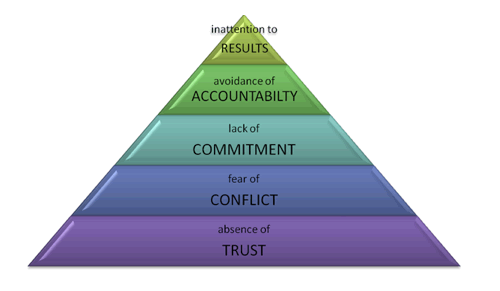Building High Functioning Teams - Lencioni’s Famous Five

One of my real passions at Incorporate Psychology is working with organisations of all sizes and experience to help them identify and address dysfunction in teams.
Like family, you can’t choose your colleagues. Often times we are put together in a team because of our different skill sets, our different personality styles and our different ways of working in an attempt to complement each other and achieve comprehensive group outcomes.
Whilst many teams can gel and work efficiently and effectively, often times there are teams which are not healthy and functioning. Understandably, this has a dire effect on not only business performance but the culture and well-being of the individuals involved.
One of my favourite models I use when working with teams, leaders and boards, is seen in Patrick Lencioni’s The Five Dysfunctions of a Team.
Lencioni’s famous model features what I interpret as a pyramid of five dimensions essential to a functioning team: Trust, Conflict, Commitment, Accountability, Results. When the team is not working well, at least some of these will be missing.

In a nutshell, Lencioni’s model speaks to five interrelated issues that undermine the performance of a team:
1) Absence of trust. If the members of the team do not trust each other then they cannot be totally honest with each other.
2) Fear of conflict. Conflict is not in and of itself a bad thing. It is actually very important for teams, in particular leadership teams. Without trust though, people will not have the healthy debates that are necessary to arrive at better thought through decisions.
3) Lack of commitment. If the team has not aligned behind a decision then the individual members who did not agree with the final decision will ultimately be less committed to that decision.
4) Avoidance of accountability. If they are not committed to the course of action, then they are less likely to feel accountable (or hold other people accountable).
5) Inattention to results. Consequently, they are less likely to care about the group results (and instead focus on achieving their own goals).
Lencioni′s model serves as a timeless reminder that leadership requires as much courage as it does insight. In theory, building cohesive and effective teams is simple, but in practice, teamwork is difficult. Building a team is a process, one that requires very high levels of discipline, courage, and persistence.
I encourage you to look more deeply at the team you lead or work with. Do any of the following behaviours in your team ring true?
Conceal your weaknesses and mistakes from one another
Hesitate to ask for help or provide constructive feedback
Hesitate to offer help outside their own areas of responsibility
Fail to recognise and tap into one another’s skills and experiences
Hold grudges
Dread meetings and find reasons to avoid spending time together
Fail to tap into all the opinions and perspectives of team members
Revisits discussions and decisions again and again
Encourages second-guessing among team members
Misses deadlines and key deliverables
Places an undue burden on the team leader as the sole source of discipline
Loses achievement-oriented employees
Ref: http://flpbs.fmhi.usf.edu/pdfs/Five%20Dysfunctions%20of%20a%20Team.pdf
Incorporate Psychology works with teams of all sizes and levels, and we often use these five dimensions based on these five factors of dysfunction. We have worked with Boards, Executive teams, small sales teams and divisional leaders. The same model and concepts apply no matter the experience or scale of the team.
Using the model involves skill. Most of us need to understand one another better and explore our threshold of comfort with conflict. Working together on building trust in your team is a challenging process; however the outcomes and results when achieved far outweigh the efforts involved.
We invite you to call us today and let’s begin planning on creating a cohesive and functioning team.
Ref: Patrick Lencioni (2002) The Five Dysfunctions of a Team




















